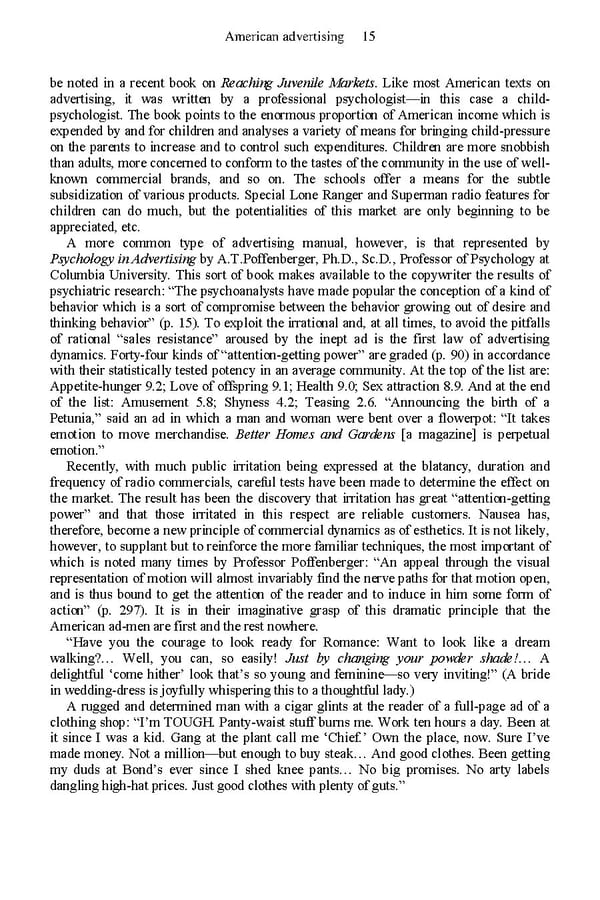American advertising 15 be noted in a recent book on Reaching Juvenile Markets. Like most American texts on advertising, it was written by a professional psychologist—in this case a child- psychologist. The book points to the enormous proportion of American income which is expended by and for children and analyses a variety of means for bringing child-pressure on the parents to increase and to control such expenditures. Children are more snobbish than adults, more concerned to conform to the tastes of the community in the use of well- known commercial brands, and so on. The schools offer a means for the subtle subsidization of various products. Special Lone Ranger and Superman radio features for children can do much, but the potentialities of this market are only beginning to be appreciated, etc. A more common type of advertising manual, however, is that represented by Psychology in Advertising by A.T.Poffenberger, Ph.D., Sc.D., Professor of Psychology at Columbia University. This sort of book makes available to the copywriter the results of psychiatric research: “The psychoanalysts have made popular the conception of a kind of behavior which is a sort of compromise between the behavior growing out of desire and thinking behavior” (p. 15). To exploit the irrational and, at all times, to avoid the pitfalls of rational “sales resistance” aroused by the inept ad is the first law of advertising dynamics. Forty-four kinds of “attention-getting power” are graded (p. 90) in accordance with their statistically tested potency in an average community. At the top of the list are: Appetite-hunger 9.2; Love of offspring 9.1; Health 9.0; Sex attraction 8.9. And at the end of the list: Amusement 5.8; Shyness 4.2; Teasing 2.6. “Announcing the birth of a Petunia,” said an ad in which a man and woman were bent over a flowerpot: “It takes emotion to move merchandise. Better Homes and Gardens [a magazine] is perpetual emotion.” Recently, with much public irritation being expressed at the blatancy, duration and frequency of radio commercials, careful tests have been made to determine the effect on the market. The result has been the discovery that irritation has great “attention-getting power” and that those irritated in this respect are reliable customers. Nausea has, therefore, become a new principle of commercial dynamics as of esthetics. It is not likely, however, to supplant but to reinforce the more familiar techniques, the most important of which is noted many times by Professor Poffenberger: “An appeal through the visual representation of motion will almost invariably find the nerve paths for that motion open, and is thus bound to get the attention of the reader and to induce in him some form of action” (p. 297). It is in their imaginative grasp of this dramatic principle that the American ad-men are first and the rest nowhere. “Have you the courage to look ready for Romance: Want to look like a dream walking?… Well, you can, so easily! Just by changing your powder shade!… A delightful ‘come hither’ look that’s so young and feminine—so very inviting!” (A bride in wedding-dress is joyfully whispering this to a thoughtful lady.) A rugged and determined man with a cigar glints at the reader of a full-page ad of a clothing shop: “I’m TOUGH. Panty-waist stuff burns me. Work ten hours a day. Been at it since I was a kid. Gang at the plant call me ‘Chief.’ Own the place, now. Sure I’ve made money. Not a million—but enough to buy steak… And good clothes. Been getting my duds at Bond’s ever since I shed knee pants… No big promises. No arty labels dangling high-hat prices. Just good clothes with plenty of guts.”
 Essential McLuhan Page 21 Page 23
Essential McLuhan Page 21 Page 23